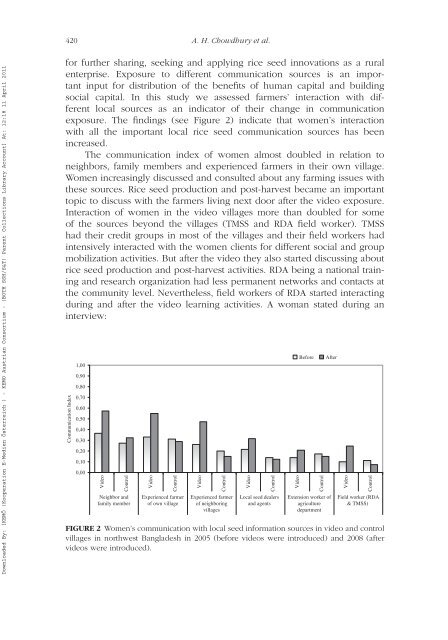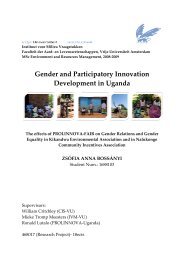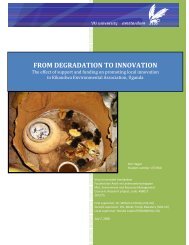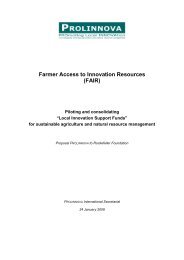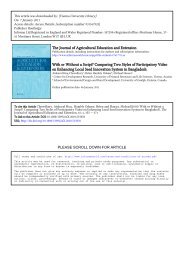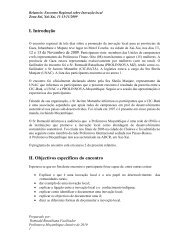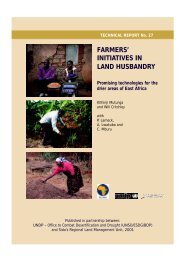Chowdhury et al (2011); PDF file - Prolinnova
Chowdhury et al (2011); PDF file - Prolinnova
Chowdhury et al (2011); PDF file - Prolinnova
You also want an ePaper? Increase the reach of your titles
YUMPU automatically turns print PDFs into web optimized ePapers that Google loves.
420 A. H. <strong>Chowdhury</strong> <strong>et</strong> <strong>al</strong>.<br />
Downloaded By: [KEMÖ (Kooperation E-Medien Österreich ) - KEMO Austrian Consortium - (BOTH SSH/S&T) Parent Collections Library Account] At: 12:18 11 April <strong>2011</strong><br />
for further sharing, seeking and applying rice seed innovations as a rur<strong>al</strong><br />
enterprise. Exposure to different communication sources is an important<br />
input for distribution of the benefits of human capit<strong>al</strong> and building<br />
soci<strong>al</strong> capit<strong>al</strong>. In this study we assessed farmers’ interaction with different<br />
loc<strong>al</strong> sources as an indicator of their change in communication<br />
exposure. The findings (see Figure 2) indicate that women’s interaction<br />
with <strong>al</strong>l the important loc<strong>al</strong> rice seed communication sources has been<br />
increased.<br />
The communication index of women <strong>al</strong>most doubled in relation to<br />
neighbors, family members and experienced farmers in their own village.<br />
Women increasingly discussed and consulted about any farming issues with<br />
these sources. Rice seed production and post-harvest became an important<br />
topic to discuss with the farmers living next door after the video exposure.<br />
Interaction of women in the video villages more than doubled for some<br />
of the sources beyond the villages (TMSS and RDA field worker). TMSS<br />
had their credit groups in most of the villages and their field workers had<br />
intensively interacted with the women clients for different soci<strong>al</strong> and group<br />
mobilization activities. But after the video they <strong>al</strong>so started discussing about<br />
rice seed production and post-harvest activities. RDA being a nation<strong>al</strong> training<br />
and research organization had less permanent n<strong>et</strong>works and contacts at<br />
the community level. Nevertheless, field workers of RDA started interacting<br />
during and after the video learning activities. A woman stated during an<br />
interview:<br />
Communication Index<br />
1,00<br />
0,90<br />
0,80<br />
0,70<br />
0,60<br />
0,50<br />
0,40<br />
0,30<br />
0,20<br />
0,10<br />
0,00<br />
Video<br />
Control<br />
Neighbor and<br />
family member<br />
Video<br />
Control<br />
Experienced farmer<br />
of own village<br />
Video<br />
Control<br />
Experienced farmer<br />
of neighboring<br />
villages<br />
Video<br />
Control<br />
Loc<strong>al</strong> seed de<strong>al</strong>ers<br />
and agents<br />
Video<br />
Before<br />
Control<br />
Extension worker of<br />
agriculture<br />
department<br />
After<br />
Video<br />
Control<br />
Field worker (RDA<br />
& TMSS)<br />
FIGURE 2 Women’s communication with loc<strong>al</strong> seed information sources in video and control<br />
villages in northwest Bangladesh in 2005 (before videos were introduced) and 2008 (after<br />
videos were introduced).


